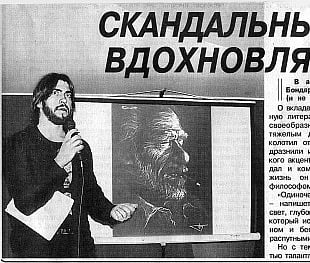Charles Bukowski
The scandalous American writer inspires Rostov aesthetes. An exhibition of graphics by Evgeny Bondarenko has opened in an art cafe. An article in the newspaper "Evening Rostov". Nov 18, 2010 Rostov-on-Don
EXHIBITIONSPUBLICATIONS
12/24/20102 min read


The controversial American writer Henry Charles Bukowski, notorious for his heavy drinking, has inspired a graphic art exhibition by Russian artist Evgeny Bondarenko at the art café “Loshka”. Bukowski's contribution to modern literature and his unique style continue to be a topic of debate among literary enthusiasts. Nevertheless, he remains a melancholic philosopher of the Beat Generation.
Bukowski's difficult childhood, which involved a father who often beat him and the teasing of his peers due to his strong German accent, left him shy, self-conscious, and with a tendency towards melancholy. He sought solace in alcohol and promiscuous relationships with women. Bukowski channeled his feelings of isolation and despair into his writing, creating works that not only conveyed a sense of loneliness, but also forced readers to experience it alongside him.
At the age of 24, Bukowski began to seriously consider writing and sent several of his stories to various publications. Although two magazines published one of his essays each, they did not generate much buzz. Disillusioned with writing, Bukowski abandoned it altogether, referring to the following ten years as his "lost decade of drinking." However, those years would serve as the foundation for his later autobiographical works.
Inspired by the tumultuous soul of Bukowski, Evgeny Bondarenko created portraits of the writer in black and white graphics. At first glance, they may seem like sketches, but upon closer inspection, the works reveal themselves to be fully formed pieces of art. The effect is that of an unfinished thought, allowing the viewer to fill in the gaps.
Bondarenko's work is characterized by its restrained style, which he says he has been developing for several years and continues to perfect. He sketches directly on paper without the use of a pencil, working from a photograph. However, he is not interested in achieving photographic accuracy, choosing instead to capture the overall mood of the subject.
The presentation of Bukowski's work was no less interesting, with Bondarenko reading Bukowski's hooligan poetry, translated into Russian and transformed into prose. During the presentation, a scene reminiscent of Bukowski's own writing played out when a slightly inebriated young man approached the stage and began asking the artist questions like, "In school, they taught us that poetry had rhyme schemes…"
In conclusion, Bukowski's life and work continue to inspire artists and writers around the world. His unique style, melancholic philosophy, and gritty, realistic portrayal of life have made him a literary icon, even in Russia. The exhibition by Evgeny Bondarenko is a testament to the ongoing relevance of Bukowski's work and the lasting impact he has had on modern literature.
















